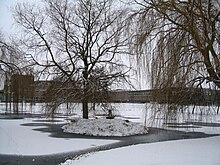Cavendish Laboratory

Southern aspect of the laboratory at its current site, viewed from across 'Payne's Pond'
|
|
| Established | 1874 |
|---|---|
| Affiliation | University of Cambridge |
| Head of Department | Andy Parker |
| Location |
Cambridge, United Kingdom Coordinates: 52°12′33.35″N 0°05′31.24″E / 52.2092639°N 0.0920111°E |
| Cavendish Professor of Physics | Richard Friend |
| Website | www |
The Cavendish Laboratory is the Department of Physics at the University of Cambridge, and is part of the School of Physical Sciences. The laboratory was opened in 1874 on the New Museums Site as a laboratory for experimental physics. The laboratory moved to its present site in West Cambridge in 1974. As of 2011[update], 29 Cavendish researchers have won Nobel Prizes.
The Cavendish Laboratory was initially located on the New Museums Site, Free School Lane, in the centre of Cambridge. After perennial space problems, it moved to its present site in West Cambridge in the early 1970s. The oak door of the new Cavendish Laboratory is known for its inscription from the Book of Psalms in the Bible: "The works of the Lord are great, sought out of all them that have pleasure therein."
The Department is named to commemorate British chemist and physicist Henry Cavendish for contributions to science and his relative William Cavendish, 7th Duke of Devonshire, who served as Chancellor of the University and donated money for the construction of the laboratory. Professor James Clerk Maxwell, the developer of electromagnetic theory, was a founder of the lab and became the first Cavendish Professor of Physics.
The Duke of Devonshire had given to Maxwell, as Head of the Laboratory, the manuscripts of Henry Cavendish's unpublished Electrical Works. The editing and publishing of these was Maxwell's main scientific work while he was at the laboratory. Cavendish's work aroused Maxwell's intense admiration and he decided to call the Laboratory (formerly known as the Devonshire Laboratory) the Cavendish Laboratory and thus to commemorate both the Duke and Henry Cavendish.
...
Wikipedia
